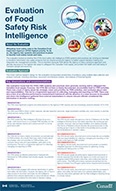Evaluation of Food Safety Risk Intelligence
About this evaluation
Mitigating food safety risks is the Canadian Food Inspection Agency's (CFIA) highest priority. To do so, the agency has systems and practices in place to identify food safety trends and risks, which continue to evolve due to increased global food production and trade, changing food preferences and accelerated technological advances. The CFIA uses risk intelligence to support food safety program design, planning, compliance and enforcement efforts.
The evaluation looked at whether CFIA's food safety risk intelligence systems and practices are working as intended to transform information into useful products that are shared across the agency to better support decision-making and integrated risk management activities. This is important because food safety risk intelligence allows the agency to take a proactive approach and allocate resources to the highest-risk areas to safeguard the Canadian food supply, and protect the health and well-being of Canada's people and economy.
The mixed method research design for this evaluation incorporated several lines of evidence using multiple data collection and analysis methods, including interviews, document and literature reviews, and analysis of financial reports.
This is the first evaluation of CFIA's food safety risk intelligence activities and covers the period April 1, 2016 to October 31, 2020.
Key findings
The evaluation found that CFIA's food safety risk intelligence systems and practices were generally working well to safeguard the Canadian food supply. The agency made significant progress and enhancements to CFIA's food safety risk intelligence systems and practices over the 4-year evaluation period (2016 to 2020). However, the evaluation also found that there were opportunities for improvement. The CFIA did not have a clearly documented, accountable lead for food safety risk intelligence activities. As a result, there was a lack of clarity about the strategic vision and priorities for food safety risk intelligence activities, and confusion about roles and responsibilities. This led to a fragmented approach to collecting, managing and reporting on food safety risk intelligence. The evaluation also found additional challenges including the lack of an effective performance measurement framework and the absence of a clear process to document and share risk intelligence gathered from external stakeholders to ensure all relevant officials received and considered the information in decision-making.
Recommendations
The evaluation recommended that the:
- CFIA should create and approve a Terms of Reference (ToR) for the Risk Intelligence Working Group (RIWG) that clearly describes the working group's mandate, structure, roles and responsibilities, and meeting schedule. This ToR should describe the governance path for the working group to report on the results of its activities, and to provide recommendations to decision-makers.
- CFIA should clarify, document and communicate the accountability, roles and responsibilities for collecting, managing and reporting on the results of the agency's food safety risk intelligence activities.
- CFIA should clarify, document and communicate a consistent, integrated approach for internal processes for gathering, storing, analyzing and taking action on food safety risk intelligence.
- CFIA should update its performance measurement framework to include measures that will allow the agency to monitor and report on progress toward food safety risk intelligence program outcomes, and continuously improve performance. The food safety risk intelligence performance measures should feed into the agency's broader Food Program performance measurement framework.
- CFIA should clarify, document and communicate the processes to gather food safety risk information from external stakeholders, and share the information gathered with the Risk Intelligence Working Group in a timely manner.
Management response
CFIA management agrees with the evaluation recommendations and has outlined an action plan, which is linked below.
Complete report
- Evaluation of Food Safety Risk Intelligence – final report
- Management response and action plan for the Evaluation of Food Safety Risk Intelligence
- Date modified:
